Access More Boat Tests
Already have an account? Login
Hysucat 8.5 (2016-)
2 x 140-hp Suzuki DF
Brief Summary
Hysucat has set out to create a faster, more fuel-efficient, and inherently more stable high performance planing power catamaran. She is intended to be a more functional platform for a wide range of uses — day boating, fishing, marina hopping, diving and snorkeling, a tender to a larger yacht — any activity in which a rigid-hull inflatable boat (RIB) usually excels.
Key Features
- 100% hand laid vacuum bagged vinyl ester construction for the deck and hull
- Anchor windlass w/remote switches at helm & windlass
- Anti-slip self-draining deck
- Central console with windshield and storage
- Hardtop box
- Helm seats with arm rests
- Electronics area that accommodates two 17’’ displays
- 4-person stern seat with lockable storage underneath
- Telescopic swim ladder
Test Results
| RPM | MPH | Knots | GPH | MPG | NMPG | STAT. MILE | NM | dBa |
|---|---|---|---|---|---|---|---|---|
| 720 | 3.1 | 2.7 | 0.6 | 4.8 | 4.2 | 304 | 264.5 | 66 |
| 1000 | 5.5 | 4.8 | 0.9 | 6.3 | 5.5 | 398 | 346.3 | 67 |
| 1500 | 7.1 | 6.2 | 1.7 | 4.2 | 3.6 | 264 | 229.6 | 67 |
| 2000 | 8.9 | 7.8 | 2.7 | 3.3 | 2.8 | 205 | 178.4 | 69 |
| 2500 | 14.7 | 12.7 | 3.3 | 4.5 | 3.9 | 283 | 246.2 | 74 |
| 3000 | 17.8 | 15.5 | 5 | 3.6 | 3.1 | 227 | 197 | 76 |
| 3500 | 23 | 20 | 5.6 | 4.1 | 3.6 | 258 | 224.6 | 81 |
| 4000 | 28.7 | 25 | 7.9 | 3.6 | 3.1 | 228 | 198.3 | 82 |
| 4500 | 33.9 | 29.4 | 10.5 | 3.2 | 2.8 | 203 | 176.9 | 88 |
| 5000 | 40.2 | 34.9 | 16.3 | 2.5 | 2.1 | 155 | 134.9 | 89 |
| 5500 | 44.9 | 39 | 18 | 2.5 | 2.2 | 157 | 136.7 | 91 |
| 6200 | 50.3 | 43.7 | 24.3 | 2.1 | 1.8 | 130 | 113.4 | 91 |
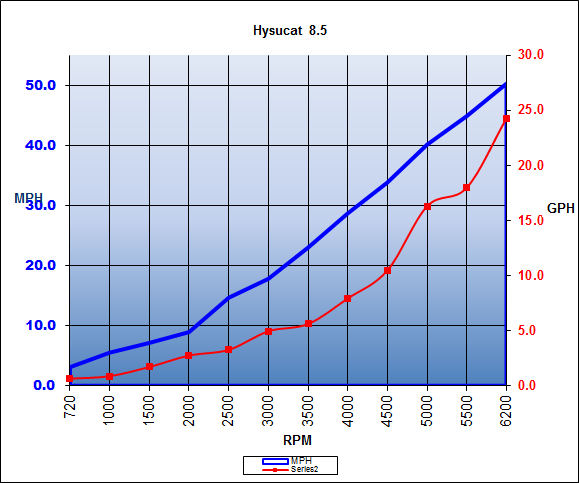
Specifications
| Length Overall | 27’ 11'' / 8.51 m |
|---|---|
| Beam |
9’ 6'' 2.89 m |
| Dry Weight |
3,400 lbs. 1,542 kg |
| Tested Weight |
4,030 lbs. 1,828 kg |
| Draft |
1’ 6'' 0.46 m |
| Deadrise/Transom | N/A |
| Max Headroom | open |
| Bridge Clearance | N/A |
| Person Capacity | 14 |
| Fuel Capacity |
70 gal. 260 L |
| Water Capacity | N/A |
| Height on Trailer |
10' 10'' 3.3 m (with T-top) |
| Total Weight |
4,030 lbs. 1,828 kg |
Acceleration Times & Conditions
| Time to Plane | 3.0 sec. |
|---|---|
| 0 to 30 | 6.0 sec. |
| Ratio | N/A |
| Props | 14x26 |
| Load | 2 persons, 1/2 fuel, no water, 50 lbs. of gear |
| Climate | 64 deg., 48 humid.; wind: 10-15 mph; seas: Light chop |
Engine Options
| Tested Engine |
2 x 140-hp Suzuki DF |
|---|---|
| Std. Power |
Not Available |
| Opt. Power |
Not Available |
Captain's Report
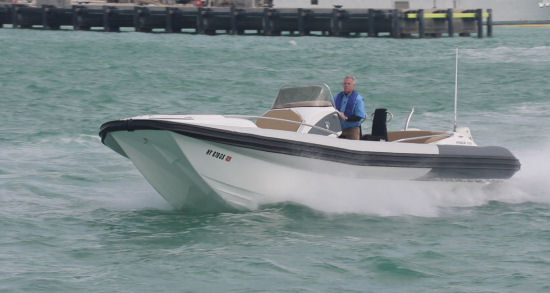
Mission
Hysucat has set out to create a faster, more fuel efficient, and inherently more stable high performance planing power catamaran. She is intended to be a more functional platform for a wide range of uses — day boating, fishing, marina hopping, diving and snorkeling, a tender to a larger yacht — any activity in which a rigid-hull inflatable boat (RIB) usually excels.
A power catamaran with those attributes will also be valuable to commercial tourism operators, law enforcement officials, emergency first responders, and the military.
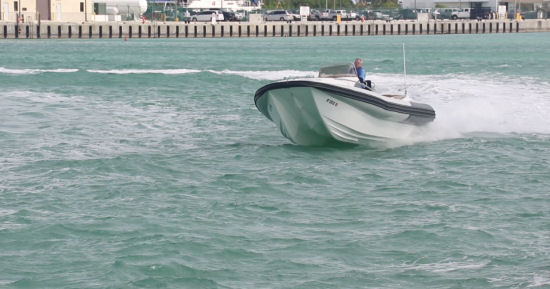
Back Story
There is nothing new about hydrofoils on boats, the concept being patented in the U.S. and Great Britain in 1898 by Enrico Forlanini. Alexander Graham Bell was an early exponent of the concept and started experimenting with hydrofoil boats on the Bras d’Or lakes in Nova Scotia in 1908. In 1919, he set the world speed record of 70.86 mph in a hydrofoil.
Throughout the 20th century hydrofoils have been used primarily for both passenger ferry and military purposes because of their speed, fuel-efficiency and load-carrying abilities.
Hysucat was founded
in South Africa by Malan Conradie. For 15 years, Conradie had worked with Professor Gunter Hoppe, a world authority on hydrofoil technology, and head of Marine Dynamics at the University of Stellenbosch in South Africa. As a result, Malan Conradie was involved with the design and development of hydrofoil supported catamarans from its earliest days.
The hulls and hydrofoils
of these new vessels were designed and proven in the test tank facility at the university and sea trials were carried out to evaluate the hydrofoil concept. Conradie did the technical design, interior and exterior design work, and Professor Hoppe designed the hydrofoils. According to the company, this led to competing in offshore powerboat events where it proved its superior design by outperforming the competition.
This collaboration resulted in the birth of the original Hysucat – “HYdrofoil SUpported CATamaran” -- which led to a new breed of hull designs that became popular in South Africa. The resulting company took the name of the new concept as its own – Hysucat.
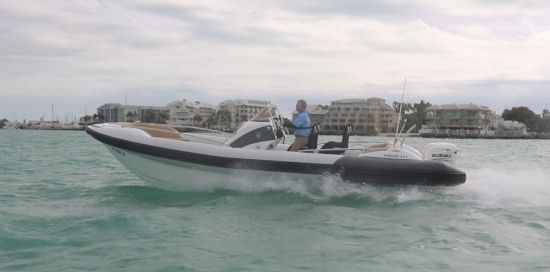
Overview
High performance planing catamaran RIBs are, by their nature, faster and more fuel-efficient than similarly sized monohull RIBs. With reduced drag from two smaller wetted surfaces instead of one big hull, they produce greater speed with similarly-sized engines than monohull RIBs. But they can also be less stable at higher speeds.
Hysucat, an acronym for Hydrofoil Supported Catamaran, brings the science of hydrofoils to performance planing catamaran RIB hulls to add lift, maintain a more moderate trim angle as speed increases – and be far more stable at high speeds.
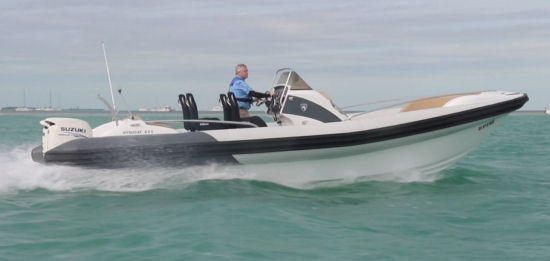
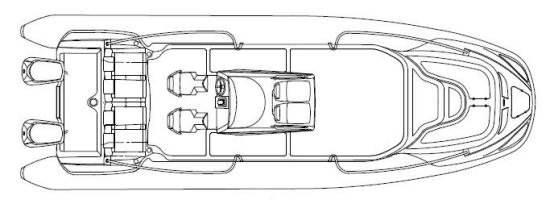
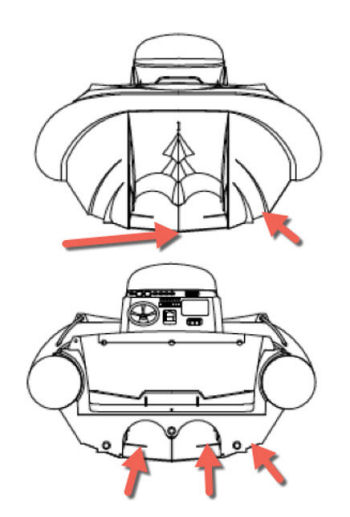
How It Works
The main foil
is a stainless steel wing in the shape of a chevron, positioned slightly ahead of the boat’s center of gravity, that spans the tunnel created by the catamaran hulls.
It is parallel with -- but not protruding below -- the bottom of the hulls, meaning that the wing is always in the water and that there may be some protection for it in case of accidental grounding.
As soon as the boat begins to move forward, water passing over and under the shape of the wing generates lift, identical to the idea behind an airplane wing. A low-pressure area is generated on the top of the wing, and a high-pressure area is formed on the bottom of the wing.
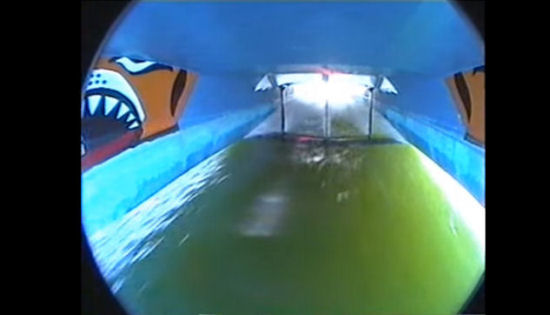
As speed increases
, lift increases, forcing the boat upwards and decreasing drag – again, just like an airplane wing. The relatively small wetted surface offered by a catamaran hull is made even smaller as lift continues.
Tunnel Affect.
There is no doubt that air trapped and compressed in the tunnel at higher speeds will also add to the lift potential before passing through the end of the tunnels at the transom.
Two More Foils.
In addition to the main foil, there are also two “trim” foils aft in the tunnel walls ahead of the transom. These act to lift the transom and help the boat run at a steady fore-and-aft attitude at low and medium speeds. In effect, the foils automatically and continuously trim the boat.
Trim foils also play a part in helping the boat reach planing speed more quickly. Unlike the main foil, they will eventually rise above the surface of the water at high speeds, and drag will be further reduced.
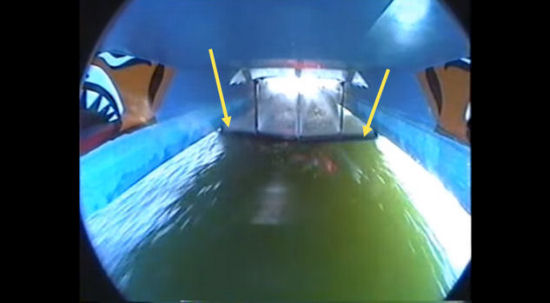
How Efficient is This System?
The builder tells us that the Lift/Drag ratio of a typical planing monohull is 4:1, while that number for the Hysucat catamaran hull with a foil is 20:1. The company also tells us that one of the benefits of the higher Lift/Drag ratio is that the boat will carry more weight at speed and require less power to do it than conventional craft — monohull or catamaran — without foils.
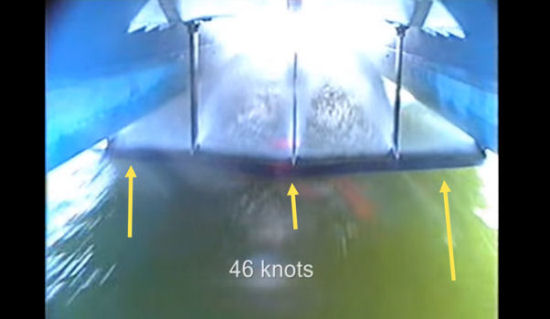
Features Inspection
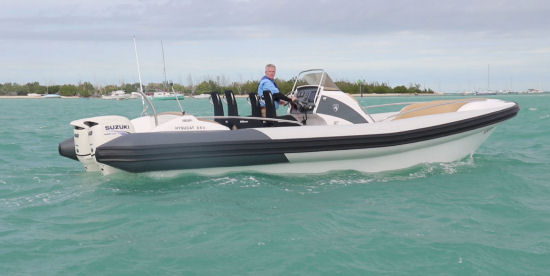
The Build.
The Hysucat 8.5’s hull and deck are hand-laid, vacuum-bagged fiberglass and vinylester resin structures. Buoyancy tubes are constructed with a total of seven chambers using Valmex PVC coated fabric engineered to withstand high-performance stresses. Mehler Technologies, which makes Valmex, says it is UV and weather-resistant, airtight and watertight, resistant to temperature extremes, and “wearproof.”
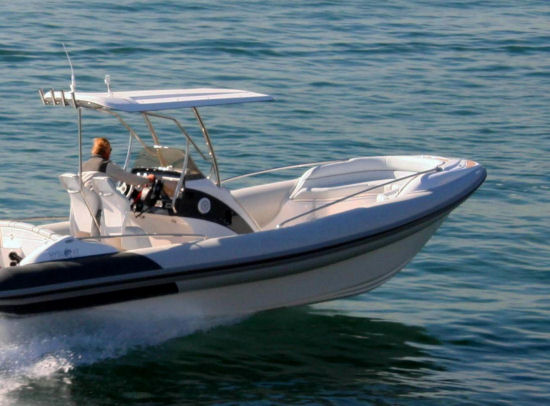
The Layout.
The Hysucat 8.5’s forward cockpit has two steps up to the bench seating level, under which there is locker storage. This is due in part to the upswept lines of the bow, which should provide a more comfortable ride in big waves.
Two stainless steel handrails, attached to the fiberglass deck structure forward and to the deck of the boat just aft of the forward edge of the console, add good security when moving around the boat. The 1’7” (.48 m) diameter inflated tubes, which have seven compartments for fail-safe buoyancy, add to the safety of the bulwarks outboard of the handrails.
The builder offers several decking solutions, including Flexiteek, which is easily maintained and helps cut down heat transmitted to bare feet.
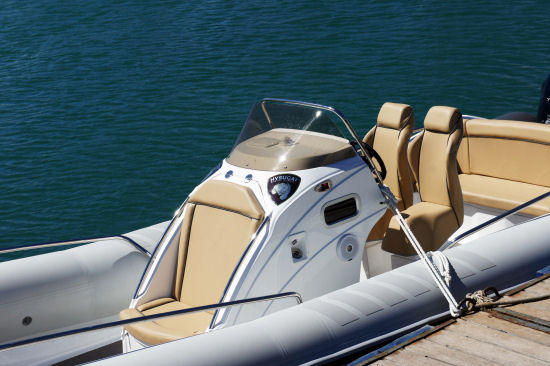
The center console
has a doublewide seat for recessed into the console, with storage under, that is flanked by thoughtfully placed stainless steel handrails. There are two long stainless steel handrails that help protect both sides of the forward and aft seating areas.
The builder has specified slip-resistant fabric pads near the center of the buoyancy tubes, just the right place to step aboard and down while having a safety rail within easy reach.
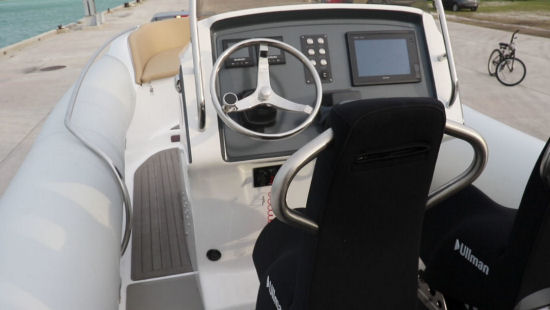
The console is also equipped with a handrail for the safety of the helmsman and mate. Grab handles on the backs of the helm console seats add security for those times when passengers wish to stand. And there are two more long handrails for the aft cockpit passengers, as well.
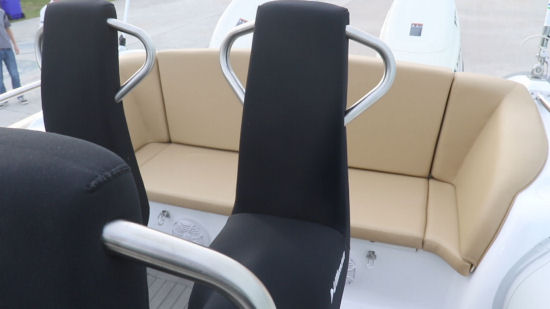
There is locker storage beneath the four-person transom seats, which are well padded and include thigh support. The 9’6” (2.89 m) beam makes this wide seating possible.
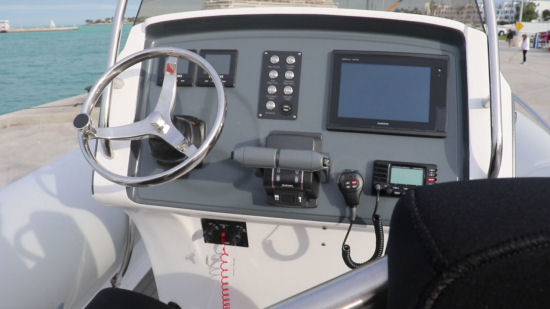
The Helm.
There’s room on this helm console for a sporty wheel, with an option for a stainless steel wheel on a tilting base. Analog-style tachometers flank a speedometer just above the rim of the wheel, and the shift-and-throttle binnacle is placed for easy use in the center of the console. The builder offers a wide range of single and double screen MFDs, and there’s room left over for a VHF radio and an autopilot.
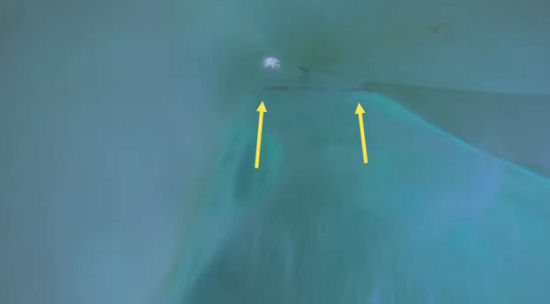
Propulsion.
Maximum recommended power is 400-hp from twin 200-hp outboards. The builder also says that a single 300-hp outboard is also possible for high performance. Minimum recommended power is 180-hp from twin 90-hp outboards. A single 150-hp engine can be used in certain applications.
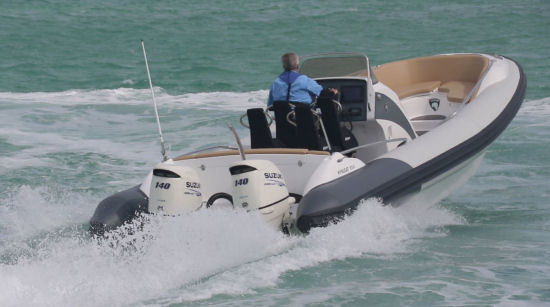
Performance
In our test, we reached a top speed of 50.3 mph at 6200 rpm. At that speed, we were burning 24.3 gph for a range of 130 miles. Best economic cruise came in at 3500 rpm and 23 mph. That brought the fuel burn down to 5.6 gph and the range up to 258 miles, all in choppy conditions and while still holding back a 10% reserve of fuel in the bank.
Handling
With the hull being supported by hydrofoils, this is without a doubt, the smoothest handling RIB we’ve been on. We tested in choppy conditions that should have rattled our fillings loose, and would so in a “normal” RIB, but this is no normal RIB. With the hydrofoils cutting through the chop, and the hull simply skating over the top, we cruised with complete comfort through the turmoil. She turns well, rolling into the turns thanks to the variable angle of the foils. Frankly, her handling was so smooth, it was easy to doubt that we were on a RIB… until we look to the sides.
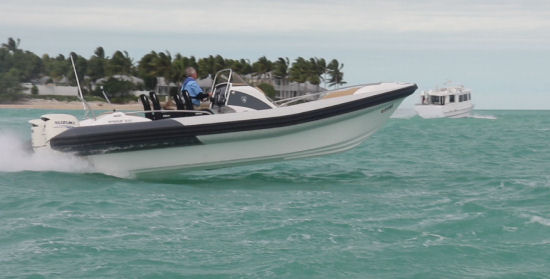
Standard Features
Options
Observations
Through intensive tank testing and construction of trial craft, the builder has achieved substantial performance and efficiency gains that will translate into popular multi-mission RIBs.
